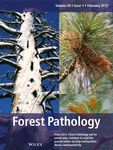Malik, 2019
No “Gadgil effect”: Temperate tree roots and soil lithology are effective predictors of wood decomposition
Malik, Rondy J. (2019)
Forest Pathology
Abstract
The “Gadgil effect” hypothesizes that root associations may slow down decomposition through pre-emptive competition. In the context of recalcitrant litter decomposition, specifically coarse wood debris, it is uncertain as to what is the relative importance of soil communities associated with living roots when compared to those without roots. Here, it is hypothesized that the presence of live roots and active photosynthates will enhance wood decomposition. To test this hypothesis, the presence or absence of temperate tree roots was used in this study. Sugar maple (Acer saccharum) and white oak (Quercus alba) roots were manipulated at three sites of either limestone or shale parent rock residuum. At each site, wood substrate was placed in soils beneath the canopy of either A. saccharum or Q. alba, while in the presence of roots (root+). At the same time, wood substrate was placed in the same soil community, but live root exposure was eliminated by trenching (root−). This eliminated active photosynthate supply to the soil microbial community. Results determined that live root exposure promoted faster decomposition and greater mycelial colonization of wood substrate. Also, sites of shale parent rock residuum had higher rates of decomposition in comparison with limestone parent rock residuum. Although additional work is needed to determine the extent in which roots and lithology can facilitate wood decomposition, these findings suggest that living roots impact decomposers and provide a pathway towards humus and soil organic matter formation.
Citation
Malik, Rondy J. (2019): No “Gadgil effect”: Temperate tree roots and soil lithology are effective predictors of wood decomposition. Forest Pathology. DOI: 10.1111/efp.12506
 This Paper/Book acknowledges NSF CZO grant support.
This Paper/Book acknowledges NSF CZO grant support.
Explore Further

